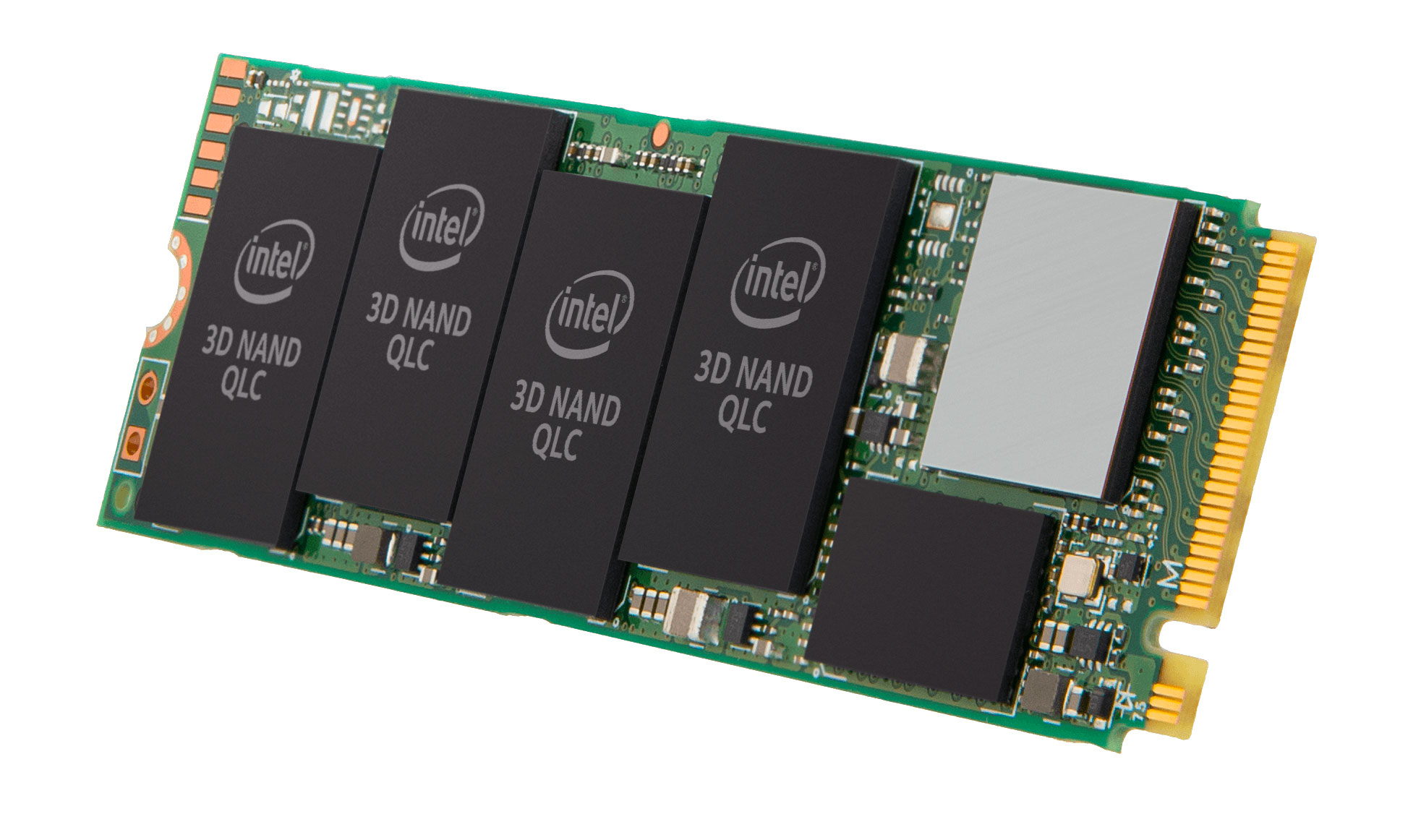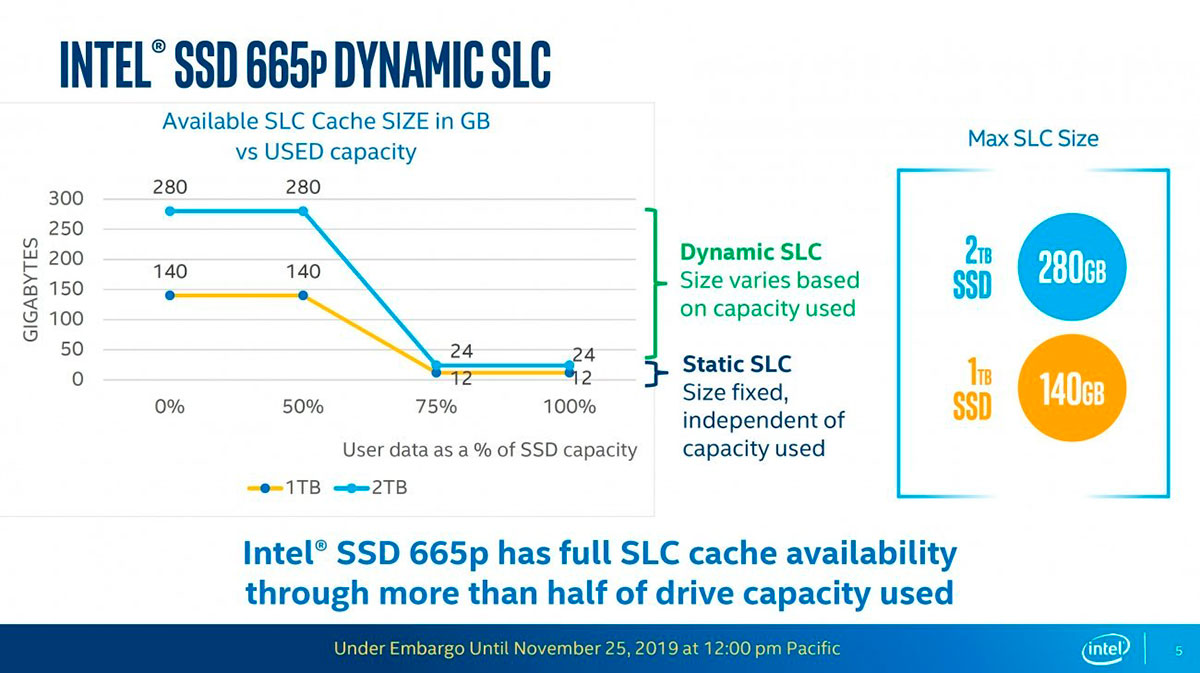Intel SSD 665p to Pack 13% More Performance, 50% More Endurance Than 660p

Intel has announced the Intel SSD 665p as the successor to the Intel SSD 660p, which we found to offer good performance and value in our testing. For the upcoming SSD, the chipmaker will not be offering a 512GB drive. Instead, the 665p will only be available in 1TB and 2TB capacities.
Like the 660p, the 665p complies with the M.2 2280 form factor and slides into a standard PCIe 3.0 x4 interface. It also uses the same Silicon Motion SM2263 SSD controller, which is paired with a small amount of DRAM cache and a considerable dynamic SLC (single-level cell) cache.
The caveat with quad-level chip (QLC)-based SSDs is that once you start saturating the cache, the performance starts to dramatically decrease. In order to combat this problem, the 665p will introduce the dynamic SLC cache feature. When the drive is at 50%, it'll have a maximum cache of 280GB for the 2TB variant and 140GB for the 1TB variant. Once the SSD breaks the halfway mark, the cache starts to decreases until it reaches a fix amount, which is 24GB for the 2TB model and 12GB for the 1TB model.

The real upgrade with the 665p is in the NAND chips. The 660p utilizes Intel's 64-layer 3D QLC chips. However, the new iteration will make use of the chipmaker's latest 96-layer 3D QLC chips. That's enough for Intel to claim that the 665p will offer up to 13% better performance and 50% higher endurance than the 660p.
Specs
| Header Cell - Column 0 | Intel SSD 665p 2TB | Intel SSD 660p 2TB | Intel SSD 665p 1TB | Intel SSD 660p 1TB |
|---|---|---|---|---|
| Sequential Read | 2,000 MBps | 1,800 MBps | 2,000 MBps | 1,800 MBps |
| Sequential Write | 2,000 MBps | 1,800 MBps | 1,925 MBps | 1,800 MBps |
| Random Read | 250,000 IOPS | 220,000 IOPS | 160,000 IOPS | 150,000 IOPS |
| Radom Write | 250,000 IOPS | 220,000 IOPS | 250,000 IOPS | 220,000 IOPS |
| Endurace | 600 TBW | 400 TBW | 300 TBW | 200 TBW |
| Warranty | 5 years | 5 years | 5 years | 5 years |
| RCP (Recommended Customer Price) | ? | $399 | $159 - $307 | $199 |
On the 2TB model, the 665p deliver up to to 11.1% higher sequential and a 13.6% boost in random performance. The 1TB model comes with mixed results. We're looking at 11.1% and 6.9% faster sequential reads and writes and 6.6% and 13.6% faster random reads and writes, respectively.
Regarding its feature set, the 665p supports AES-256 encryption, Pyrite 2.0, Enhanced Power Loss Data Protection and End-to-End Data Protection.
The Intel SSD 665p 1TB should be available in this quarter, while the 2TB variant is expected to land in the first quarter of 2020. The 1TB drive has a Recommended Customer Price (RCP) between $159 and $307. As usual, Intel will back the 665p with a limited five-year warranty.
Get Tom's Hardware's best news and in-depth reviews, straight to your inbox.

Zhiye Liu is a news editor, memory reviewer, and SSD tester at Tom’s Hardware. Although he loves everything that’s hardware, he has a soft spot for CPUs, GPUs, and RAM.
-
cryoburner ReplyIn order to combat this problem, the 665p will introduce the dynamic SLC cache feature. When the drive is at 50%, it'll have a maximum cache of 280GB for the 2TB variant and 140GB for the 1TB variant. Once the SSD breaks the halfway mark, the cache starts to decreases until it reaches a fix amount, which is 24GB for the 2TB model and 12GB for the 1TB model.
This sounds like what the 660p already does. The dynamic cache starts at 140GB for the 1TB model, and works its way down to 12GB when 75% full, and the 2TB model doubles that, with both matching the numbers listed here. I believe the 660p starts reducing its cache around the 25% mark though, so perhaps they adjusted the curve for the new model to maintain more of that cache when a larger portion of the drive is filled.
A $160 MSRP for the 1TB 665p doesn't seem all that attractive when the 1TB 660p has been widely available for under $100 for the last 6 months though. Based on these numbers, the improvements seem quite minor, after all, and probably not worth paying substantially more for. -
rodagon I believe other NVMe SSD manufactures offer vastly superior performance and reliability compared to the Intel (QLC)-based SSDs. The Intel 660P was a good deal last year. Now that there have been many price decreases, I would look at brands that offer more than 3000 mbps read and write speeds. This is superb for photo editing and large music file transfers such as 4tb DSD files. There is also a great benefit in speeds from Thunderbolt 3 external NVMe drives on true Thunderbolt 3 ports. Look at Patriot, HP 950, Samsung 970, etc.Reply